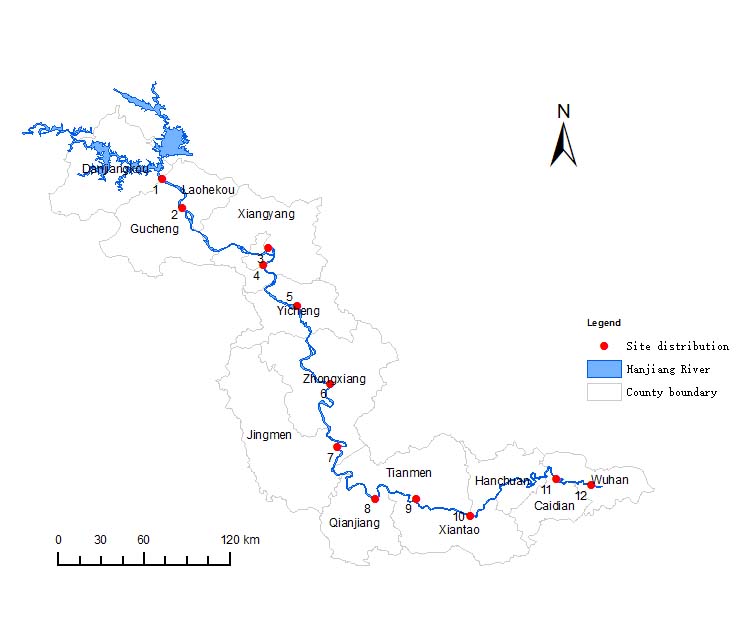

汉江中下游水生植物群落及演替
# 共同第一作者
收稿日期: 2015-11-29
录用日期: 2016-03-25
网络出版日期: 2016-12-02
基金资助
国家自然科学基金(No.31270261, No.31570366)和国家科技基础性工作专项(No.2013FY112300)
Community Succession of Macrophytes in the Middle and Lower Reaches of the Hanjiang River
# Co-first authors
Received date: 2015-11-29
Accepted date: 2016-03-25
Online published: 2016-12-02
水生植物是河流生态系统的重要组成部分, 研究河流水生植物群落组成及演替对于河流生态系统健康诊断具有重要意义。该研究采用野外生态学研究方法, 于2013年9月和2014年6月2次对汉江中下游12个典型代表性江段的水生植物群落的组成、分布和生物量等进行调查。调查结果表明, 现阶段汉江中下游的主要水生植物共有69种, 隶属28科49属, 其中优势种主要是穿叶眼子菜(Potamogeton perfoliatus)、竹叶眼子菜(P. malaianus)、芦苇(Phragmites australis)、南荻(Triarrhena lutarioriparia)和喜旱莲子草(Alternanthera philoxeroides)等。结合早期的研究表明, 汉江中游江段沉水植物优势群落变化明显; 下游则呈现出由沉水植物群落向挺水植物群落演替的格局。挖沙和污染等人类干扰以及水位波动、河流底质和植物繁殖策略等自然因素可能是导致汉江中下游水生植物优势种变化和群落演替的主要因素。该研究结果可为汉江中下游的水生植物多样性保护和生态修复提供科学依据。

龚旭昇 , 李中强 , 汪正祥 , 邓绪伟 , 郭葳 . 汉江中下游水生植物群落及演替[J]. 植物学报, 2016 , 51(6) : 782 -789 . DOI: 10.11983/CBB15210
Aquatic plants are an important part of river ecosystems, and study of the composition and succession of river aquatic plant communities is important for diagnosing river ecosystem health. In this study, we studied the aquatic plant diversity in the middle and lower reaches of the Hanjiang River, especially the species and community diversity, by field investigation in September 2013 and June 2014. We found 69 species of macrophytes belonging to 28 families, with 49 genera. The dominant species were Potamogeton perfoliatus, P. malaianus, Phragmites australis, Triarrhena lutarioriparia and Alternanthera philoxeroides. The pattern of macrophyte community succession was from submerged to emergent macrophyte community. The main reasons for species replacement and community succession of aquatic plants were human disturbances such as sand-excavation and pollution and natural factors such as water-level fluctuation, river sediment and reproduction strategy. Our study provides a scientific basis for the protection and ecological restoration of macrophytes and river ecosystem in the middle and lower reaches of the Hanjiang River.

| [1] | 陈洪达 (1980). 武汉东湖水生维管束植物群落的结构和动态. 海洋与湖沼 11, 275-284. |
| [2] | 戈峰 (2008). 现代生态学(第二版). 北京: 科学出版社. pp. 340-343. |
| [3] | 谷金普, 葛继稳, 唐佳, 吴述园 (2014). 古夫河着生藻类优势种生态位研究. 长江流域资源与环境 23, 1456-1463. |
| [4] | 李爱民, 高振美, 段娟娟 (2014). 人类干扰对洪泽湖湿地植被分布格局的影响. 湿地科学与管理 10, 57-60. |
| [5] | 李慧, 刘妍, 范亚文, 国超旋 (2014). 三江平原湿地同江地区水域夏季浮游植物群落结构特征. 植物学报 49, 440-449. |
| [6] | 李君, 周琼, 谢从新, 王军, 韦丽丽 (2014). 新疆额尔齐斯河周丛藻类群落结构特征研究. 水生生物学报 38, 1033-1039. |
| [7] | 李中强, 任慧, 郝梦曦 (2012). 斧头湖水生植物多样性及群落演替研究. 水生生物学报 36, 1018-1026. |
| [8] | 沈亚强, 张晓可, 赵伟华 (2011). 黄河干流河岸带植物群落特征及其影响因子分析. 水生生物学报 35, 51-66. |
| [9] | 吴中华, 于丹, 涂芒辉 (2002). 汉江水生植物多样性研究. 水生生物学报 26, 348-356. |
| [10] | 吴中华, 于丹, 王东 (2003). 汉江水生植物群落的结构与数量特征. 植物生态学报 27, 118-124. |
| [11] | 吴振斌 (2011). 水生植物与水体生态修复. 北京: 科学出版社. pp. 27-28. |
| [12] | 吴振斌, 陈德强, 邱东茹 (2003). 武汉东湖水生植被现状调查及群落演替分析. 重庆环境科学 25, 54-58. |
| [13] | 徐新伟, 吴中华, 于丹 (2002). 汉江中下游水生植物多样性及南水北调工程对其影响. 生态学报 22, 1933-1938. |
| [14] | 严国安, 马剑敏, 邱东茹, 吴振斌 (1997). 武汉东湖水生植物群落演替的研究. 植物生态学报 21, 319-327. |
| [15] | 杨龙元, 梁海棠, 胡维平 (2002). 太湖北部滨岸区水生植被自然修复观测研究. 湖泊科学 14, 60-66. |
| [16] | 姚鑫, 杨桂山, 万荣荣 (2014). 水位变化对河流、湖泊湿地植被的影响. 湖泊科学 26, 813-821. |
| [17] | 于丹 (1995). 激流植物群落生态学研究. 水生生物学报 19, 31-39. |
| [18] | 章光新 (2012). 水文情势与盐分变化对湿地植被的影响研究综述. 生态学报 32, 4254-4260. |
| [19] | 周万平, 郭晓鸣, 陈伟民 (1994). 南水北调东线一期工程对洪泽湖水生生物及生态环境影响的预测. 湖泊科学 6, 131-135. |
| [20] | Rexford D (陈庆诚译) (1981). 植物群落——植物群落生态学教程. 北京: 人民教育出版社. pp. 113-183. |
| [21] | Alahuhta J (2015). Geographic patterns of lake macrophyte communities and species richness at regional scale.J Veg Sci 26, 564-575. |
| [22] | Barko JW, Gunnison D, Carpenter SR (1991). Sediment interactions with submerged macrophyte growth and com- munity dynamics.Aquat Bot 41, 41-65. |
| [23] | Capers R, Selsky R, Bugbee GJ (2010). The relative importance of local conditions and regional processes in structuring aquatic plant communities.Freshwater Biol 55, 952-966. |
| [24] | Cook CDK (1990). Aquatic Plant Book. The Hague. Nether- lands: SPB Academic Publishing. pp. 1-6. |
| [25] | Coops H, Beklioglu M, Crisman TL (2003). The role of water-level fluctuations in shallow lake ecosystems-work- shop conclusions.Hydrobiologia 506, 23-27. |
| [26] | Dalton RL, Boutin C, Pick FR (2015). Nutrients override atrazine effects on riparian and aquatic plant community structure in a North American agricultural catchment.Fre- shwater Biol 60, 1292-1307. |
| [27] | Forman RTT (1995). Land mosaics—the ecology of land- scape and regions. New York: Cambridge University Pre- ss. pp. 23-25. |
| [28] | Hey RD (1994). Impact of flood alleviation schemes on aquatic macrophytes.Regul River Res Manage 9, 103-119. |
| [29] | Jones JI, Collins AL, Naden PS, Sear DA (2012). The relationship between fine sediment and macrophytes in rivers.River Res Appl 28, 1006-1018. |
| [30] | Kaenel BR, Heinrich B, Urs U (2000). Effects of aquatic plant management on stream metabolism and oxygen balance in streams.Freshwater Biol 45, 85-95. |
| [31] | May L, Carvalho L (2010). Maximum growing depth of macrophytes in loch leven, Scotland, United Kingdom, in relation to historical changes in estimated phosphorus loading.Hydrobiologia 646, 123-131. |
| [32] | Melzer A (1999). Aquatic macrophytes as tools for lake management.Hydrobiologia 396, 181-190. |
| [33] | Nǒges P, Tuvikene L, Nǒges T, Kisand A (1999). Primary production, sedimentation and resuspension in large shal- low Lake Vortsjarv. Aquat Sci 61, 168-182. |
| [34] | OZkan K, Jeppesen E, Johansson LS, Beklioglu M (2010). The response of periphyton and submerged mac- rophytes to nitrogen and phosphorus loading in shallow warm lakes: a mesocosm experiment.Freshwater Biol 55, 463-475. |
| [35] | Pinguet YL, Liancourt P, Gross N, Straile D (2012). Indi- rect facilitation promotes macrophyte survival and growth in freshwater ecosystems threatened by eutrophication.J Ecol 100, 530-538. |
| [36] | Titus JE (1992). Submersed macrophyte growth at low pH II. CO2×sediment interactions.Oecologia 92, 391-398. |
| [37] | Van OM, Van GN, Maltby E, Mockler N, Spink A, Verhoeven J (2000). Experimental manipulation of water levels in two French riverine grassland soils.Acta Oecol 21, 49-62. |
| [38] | Wu AP, Wu SK, Ni LY (2005). Study of macrophytes nitro- gen and phosphorus contents of the shallow lakes in the middle reaches of Changjiang River.Acta Hydrobiol Si- nica 29, 406-412. |
| [39] | Zuidam BG, Peeters ET (2015). Wave forces limit the establishment of submerged macrophytes in large shallow lakes.Limnol Oceanogr 60, 1536-1549. |
/
| 〈 |
|
〉 |